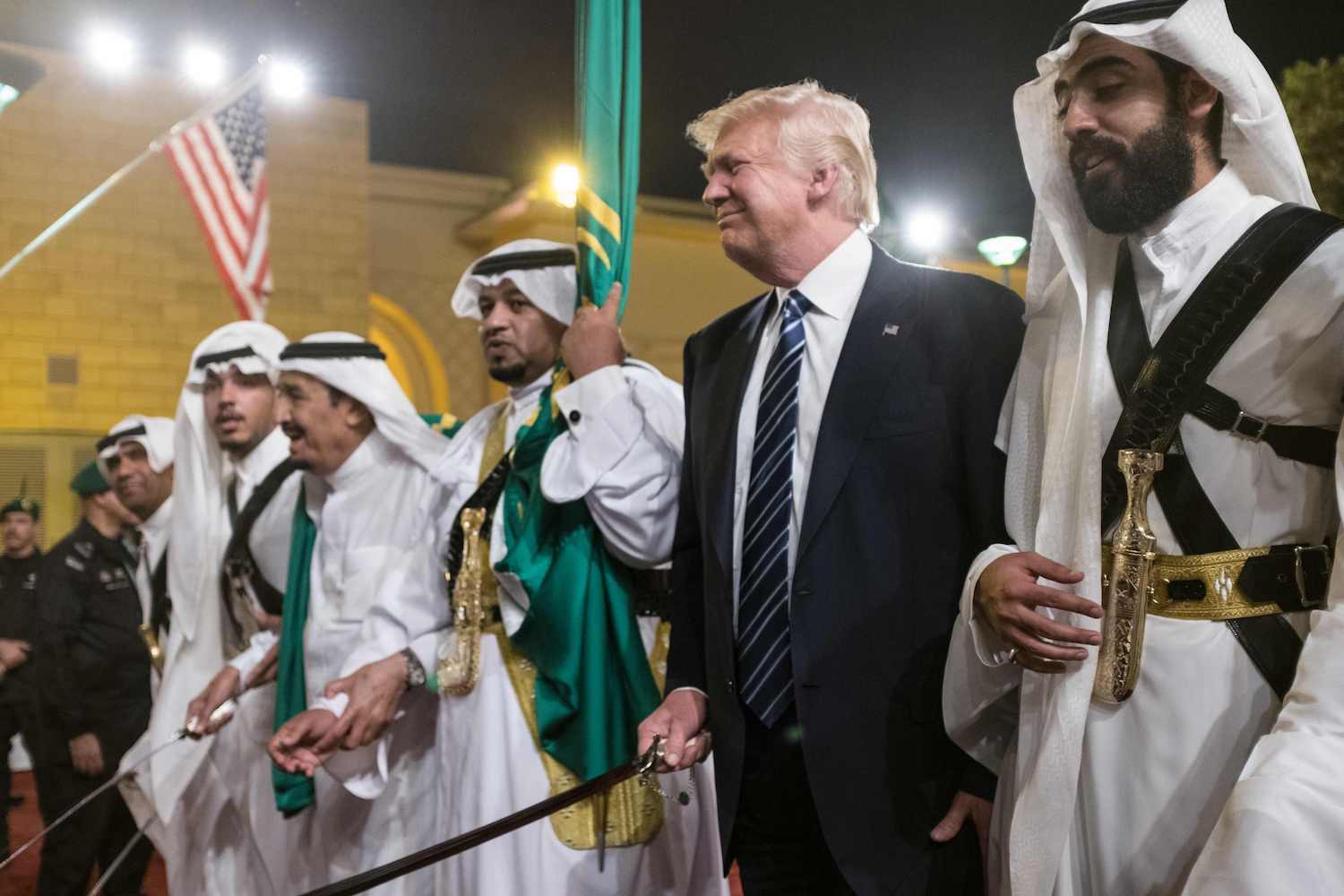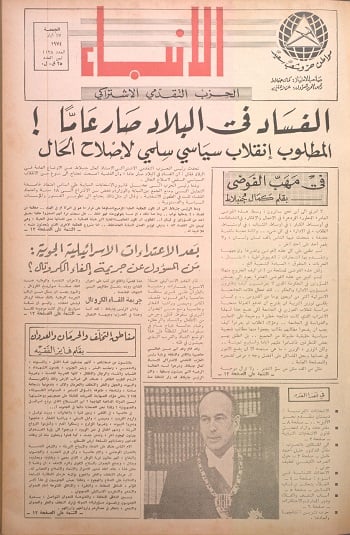Trump’s Middle East Strategy Is Totally Boring
1 مارس 2018

It has become banal to say that the Middle East is a mess and that the region’s absurd maelstrom of death, violence, degradation, corruption, extremism, and authoritarianism is made worse by the Donald Trump administration’s apparent absence of any strategy. Trump’s approach to the region seems at first glance to be all sword dancing, orb-gripping, and tough-guy rhetoric that is dangerously lacking in substance.
It is certainly fun to think so. But upon closer inspection, Secretary of State Rex Tillerson’s recent trip to the region reveals a coherent underlying plan. And in contrast to the policies that have destabilized domestic politics or raised questions in Europe, North America, and Asia about U.S. commitments to mutual defense and free trade — hallmarks of the post-World War II and post-Cold War orders — there is a certain familiarity to the Trump administration’s approach to the Middle East. In fact, it restores a regional strategy that has long had broad bipartisan support and was once the standard for U.S. presidents – just not the most recent ones.
It may be hard to see this strategy given Tillerson’s air of unceasing exasperation. And why wouldn’t he be annoyed? His five-day, five-country tour of the Middle East this month seemed guaranteed to heighten his apparent preternatural irritation. In his first stop, Egypt, Tillerson met with President Abdel Fattah al-Sisi, who is currently making a mockery of the upcoming March 26-28 presidential election by jailing and disqualifying a variety of challengers. From Cairo, it was on to the Kuwaiti capital for a meeting of the anti-Islamic State coalition, where Tillerson had to remind members to focus on fighting extremists rather than each other. He also attended the much-anticipated conference on Iraqi reconstruction and made the case for investment in a country the United States broke.
The following day, America’s chief diplomat landed in Amman for talks with every American politician’s favorite monarch, King Abdullah II of Jordan, who remains angry that the Trump administration undercut him and recognized Jerusalem as Israel’s capital. Then there was a short stop in Lebanon — the first visit by a U.S. secretary of state in four years — to “affirm [American] support for Lebanon as it confronts a wide range of challenges.” And finally, there was last Friday’s sojourn to Turkey, where Tillerson walked into a buzz saw of anger about American support for a Syrian Kurdish force that Ankara regards as part of a terrorist organization that has been spilling Turkish blood since the mid-1980s.
Through all the noise of the apparent failure of the Iraqi reconstruction conference and Turkish President Recep Tayyip Erdogan’s threat to deal U.S. military officers an “Ottoman slap,” the basic message of Tillerson’s trip was that the United States will privilege interests over values in the region. This, incidentally, looks more like the American approach to the Middle East of the 1980s and 1990s than some wild Trump desert-bender that American commentators have come to expect. No doubt there have been a few head-scratchers over the last year, most recently the Jerusalem decision, but even that fits neatly into a past pattern of U.S. policy. If people do not like Trump’s policies in the Middle East, it likely has less to do with Trump — even as scandal-ridden and truly odious his presidency has been so far — than the shortcomings of America’s longstanding policies in the region.
So, what are these policies? There are three basic components: fighting terrorism, containing Iran, and supporting Israel. That’s why Tillerson’s meetings in Cairo with Sisi and Foreign Minister Sameh Shoukry were the easiest of the trip. That is because the Trump team is reviving a policy of supporting “our bastards” so long as they share American interests. Of course, an anonymous State Department official affirmed that Tillerson raised Washington’s “concerns” over Egypt’s profoundly repressive politics, but the encounters with Sisi and Shoukry were predominantly about counterterrorism, security, and putting the U.S.-Egypt relationship back on the strategic footing of the past. In Kuwait, Tillerson did not offer much for Iraq’s reconstruction — Trump believes the United States has done its fair share and more — given that the administration’s Iraq policy has become about containing Iranian power now that the threat of the self-proclaimed Islamic State to Iraq is no longer existential. The other part of his trip to Kuwait was dedicated to maintaining the fight against extremism and terrorism.
In Amman, Tillerson demonstrated that no matter how angry a strategic ally may be, the United States’ special relationship with Israel will take precedence. In order to smooth over the difference between the United States and Jordan over Jerusalem, Tillerson came bearing a memorandum of understanding promising additional aid. The stopover in Lebanon was meant to demonstrate support for the Lebanese state in the administration’s regional strategy to contain Iran. The secretary of state may have complicated matters by recognizing Hezbollah’s important place in Lebanese politics, but the overall goal was to bolster anti-Iran forces in the country. Finally, in Ankara, Tillerson demonstrated that even the fury of a NATO ally will not deter the United States from fighting terrorism and containing the Iranians, which is what Washington’s relationship with the Syrian Kurdish People’s Protection Units (YPG) is all about. The YPG has been an effective partner in fighting the Islamic State — even if it is connected to the Kurdistan Workers’ Party, which has been waging an insurgency against Turkey for three decades — and will be part of a long-term American presence in Syria to deter and contain Iran.
If all of this seems reminiscent of 1999 or even 1989, that’s because it is. For all the collective shock about Trump’s egregious violation of norms and principles that were critical to American power and success over the last 70 years, in the Middle East, at least, he is moving U.S. policy away from the radicalism of his two predecessors. President George W. Bush vowed not to be a nation-builder abroad, but the trauma of the attacks on New York and Washington in September 2001 produced an effort to remake the Middle East through a combination of force and moral suasion. Democracy promotion was something to which previous administrations had only paid lip service. More recently, President Barack Obama believed that the best way to stabilize the region was to bring Iran into it — the first step of which was the Iran nuclear deal — thereby reducing tension and Tehran’s incentive for adventurism. Neither approach worked, so Trump has done something that for him is radical: He has restored an American strategy in the Middle East that the establishment has long favored.
It is an approach that lacks imagination, but it is also perfectly understandable because it gets the United States back to basics in the Middle East — securing the oil flow, assisting Israel, holding Iran in check, and fighting terrorists. If Washington has to work with some bad guys to fight other bad guys to ensure these interests, well then so be it. It worked before, didn’t it? It did, but not always so well and not as easily as the hindsight of the past 15 difficult years in the Middle East might suggest. The Trump administration’s approach also reflects a previous version of the Middle East that Tillerson, a former CEO of ExxonMobil, knows well. And for Defense Secretary James Mattis and national security advisor H.R. McMaster, it goes back to a time before they were sent off to fight in a misbegotten war and before the U.S. military was forced to nation-build, fight terrorists, deter enemies, and referee between allies in the region.
Going back to what seems like simpler times to stanch the bleeding may seem like a good idea. Perhaps it will work. But the world has turned a few times since Egyptian President Hosni Mubarak was hosting counterterrorism conferences in Sharm el-Sheikh. The strategy of the past was built on the idea of American predominance in the region. But while the United States is still able to bring tremendous force to bear against a variety of regional foes, its allies no longer pay heed to American interests. The days when Israelis, Saudis, Emiratis, Turks, and others sought Washington’s permission to embark on a policy or looked to the White House to provide order and stability are long gone. Now they take matters into their own hands, which has its own consequences for the region regardless of Washington’s wishes. The brutal reality is that no matter what Washington does, the Middle East will likely continue to be authoritarian and unstable.
 عن أمل جنبلاط المتجدد: لبنان يستحق النضال
عن أمل جنبلاط المتجدد: لبنان يستحق النضال
 صحافيون أم عرّافون!
صحافيون أم عرّافون!
 ماذا يجري داخل أروقة بيت الكتائب المركزي؟
ماذا يجري داخل أروقة بيت الكتائب المركزي؟


 عن الخرائط التي تُرسم والإتفاقات التي تتساقط!
عن الخرائط التي تُرسم والإتفاقات التي تتساقط!
 “الإنحراف في الحياة”/ بقلم كمال جنبلاط
“الإنحراف في الحياة”/ بقلم كمال جنبلاط
 هاشتاغ #صار_الوقت يحل أولاً في حلقة جنبلاط
هاشتاغ #صار_الوقت يحل أولاً في حلقة جنبلاط
 طاولة نقاش عن أزمة الصحافة في جامعة AUST
طاولة نقاش عن أزمة الصحافة في جامعة AUST
 عبدالله: ليظهر لنا وزير مكافحة الفساد حرصه في صفقات البواخر والفيول
عبدالله: ليظهر لنا وزير مكافحة الفساد حرصه في صفقات البواخر والفيول
 عبدالله: غريب أمر وزارة مكافحة الفساد!
عبدالله: غريب أمر وزارة مكافحة الفساد!

 Comment to Uri Avnery: How Sad What Is Looming Ahead
Comment to Uri Avnery: How Sad What Is Looming Ahead
 “Not Enough!”
“Not Enough!”
 … لمن لم يقرأ يوسف البعيني/ بقلم وسام شيّا
… لمن لم يقرأ يوسف البعيني/ بقلم وسام شيّا
 كمال جنبلاط في مولده الأول بعد المائة: تعاليمه وأفكاره ما زالت الحلّ/بقلم عزيز المتني
كمال جنبلاط في مولده الأول بعد المائة: تعاليمه وأفكاره ما زالت الحلّ/بقلم عزيز المتني
 رئيس حزب/ وليس (… سابقاً)/ بقلم د. خليل احمد خليل
رئيس حزب/ وليس (… سابقاً)/ بقلم د. خليل احمد خليل
 التوازن السياسي في لبنان
التوازن السياسي في لبنان
 لبنان… مشاريع انقلابية مؤجلة
لبنان… مشاريع انقلابية مؤجلة
 جنبلاط وحَمَلة أختام الكاوتشوك
جنبلاط وحَمَلة أختام الكاوتشوك
 Le Liban est un symbole de tolérance
Le Liban est un symbole de tolérance
 Our Automated Future
Our Automated Future
 The True Origins of ISIS
The True Origins of ISIS
 Les Misérables vs. Macron
Les Misérables vs. Macron
 عذراً أيها المعلم/ بقلم مهج شعبان
عذراً أيها المعلم/ بقلم مهج شعبان
 رساله الى المعلم / بقلم ابو عاصم
رساله الى المعلم / بقلم ابو عاصم
 إلى روح القائد والمعلم كمال جنبلاط/ بقلم أنور الدبيسي
إلى روح القائد والمعلم كمال جنبلاط/ بقلم أنور الدبيسي
 أسرار وعناوين الصحف ليوم الجمعة 14 كانون الاول 2018
أسرار وعناوين الصحف ليوم الجمعة 14 كانون الاول 2018














